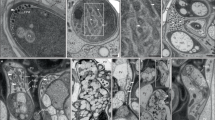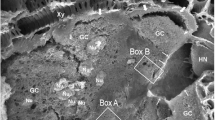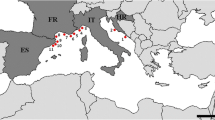Summary
Using tissue stained en bloc with chromic acid or tissue prepared by high pressure-freezing and freeze-substitution, it was possible to analyze quantitatively the ultrastructure of symbiotic vesicle envelopes (SVE) inAlnus serrulata, Ceanothus americanus, Elaeagnus umbellata, andMyrica cerifera. The lamina measured about 4.7 nm in thickness in thin section. Despite diverse symbiotic vesicle morphology, the SVE thickness was similar in all of these symbioses: 36–71 nm, which corresponded to 6–15 laminae based on counts of chromic acid-stained SVEs. This similarity in structure suggests that a similar environmental signal regulates envelope thickness in the different root nodules. Based on previous studies, this is likely to be pO2. Three types of envelope morphologies were distinguished: (1) theAlnus-type (as inAlnus andElaeagnus), which had localized thickenings around the vesicle and had thickest dimensions over the stalk; (2) theCeanothus-type. characterized as a relatively uniform envelope over both vesicle and attached hypha, and (3) theMyrica-type, which had no stalk region and a basal SVE thickness of about six laminae throughout except where localized thickening occurred. Localized thickening of the SVE resulted from extra numbers of laminae being deposited, generally over regions where septa contacted the edge of the vesicle. Freeze-substituted symbiotic vesicles had a variety of novel structures that are poorly preserved in chemically-fixed tissue. A paracrystalline body inAlnus symbiotic vesicles may be composed of particles that also exist free in the symbiotic vesicle cytoplasm. In addition, a previously unknown complex at the base of theAlnus-type symbiotic vesicle and within its stalk was evident in freeze-substituted tissues.
Similar content being viewed by others
Abbreviations
- HPF/FS:
-
high pressure-frozen/freeze-substituted
- SV:
-
symbiotic vesicle
- SVE:
-
symbiotic vesicle envelope
References
Abeysekera RM, Newcomb W, Silvester WB, Torrey JG (1990) A freeze-fracture electron microscopic study ofFrankia in root nodules ofAlnus incana grown at three oxygen tensions. Can J Microbiol 36: 97–108
Benson DR, Silvester WB (1993) Biology ofFrankia strains, actinomycete symbionts of actinorhizal plants. Microbiol Rev 57: 293–319
Berg RH (1993) High-pressure freezing improves quantitative and qualitative structural data in the actinomycete microsymbiontFrankia. In: Bailey GW, Rieder CL (eds) Proceedings of the Annual Meeting of the Microscopy Society of America. San Francisco Press, San Francisco, pp 110–111
—, Lechevalier MP (1985) Use of electron microscopy in identifyingFrankia isolates. In: Evans HJ, Bottomley PJ, Newton WE (eds) Nitrogen fixation research progress. Martinus Nijhof, Dordrecht, p 437
—, McDowell L (1987) Endophyte differentiation inCasuarina actinorhizae. Protoplasma 136: 104–117
— — (1988) Cytochemistry of the wall of infected cells inCasuarina actinorhizae. Can J Bot 66: 2038–2047
Berry AM, Harriott OT, Moreau RA, Osman SF, Benson DR, Jones AD (1993) Hopanoid lipids compose theFrankia vesicle envelope, presumptive barrier of oxygen diffusion to nitrogenase. Proc Natl Acad Sci USA 90: 6091–6094
Gardner IC, Gatner EMS (1973) The formation of vesicles in the developmental cycle of the nodular endophyte ofHippophae rhamnoides L. Arch Microbiol 89: 233–240
Gilkey JC, Staehelin LA (1986) Advances in ultrarapid freezing for the preservation of cellular ultrastructure. J Electron Microsc Tech 3: 177–210
Harriott OT, Khairallah L, Benson DR (1991) Isolation and structure of the lipid envelopes from the nitrogen-fixing vesicles ofFrankia sp. strain Cpll. J Bacteriol 173: 2061–2067
Harris SL, Silvester WB (1992) Oxygen controls the development ofFrankia vesicles in continuous culture. New Phytol 121: 43–48
Lalonde M (1979) Immunological and ultrastructural demonstration of nodulation of the EuropeanAlnus glutinosa (L.) Gaertn. host plant by an actinomycetal isolate from the North AmericanComptonia peregrina (L.) Coult. root nodule. Bot Gaz [Suppl] 140: S35-S43
—, Knowles R, Devoe IW (1976) Absence of “void area” in freezeetched vesicles of theAlnus crispa var. mollis Fern, root nodule endophyte. Arch Microbiol 107: 263–267
Lamont HC, Silvester WB, Torrey JG (1988) Nile red fluorescence demonstrates lipid in the envelope of vesicles from N2-fixing cultures ofFrankia. Can J Microbiol 34: 656–660
Lancelle SA, Torrey JG, Hepler PK, Callaham DA (1985) Ultrastructure of freeze-substitutedFrankia strain HFPCcl3, the actinomycete isolated from root nodules ofCasuarina cunninghamiana. Protoplasma 127: 64–72
Moor H (1987) Theory and practice of high-pressure freezing. In: Steinbrecht RA, Zierold K (eds) Cryotechniques in biological electron microscopy. Springer, Berlin Heidelberg New York Tokyo, pp 175–191
Newcomb W, Wood SM (1987) Morphogenesis and fine structure ofFrankia (Actinomycetales): the microsymbiont of nitrogenfixing actinorhizal root nodules. Int Rev Cytol 109: 1–88
—, Jackson S, Racette S, Torrey JG (1990) Ultrastructure of infected cells in the actinorhizal root nodules ofGymnostoma papuanum (Casuarinaceae) prepared by high-pressure freezing and chemical fixation. Protoplasma 157: 172–181
Parsons R, Silvester WB, Harris S, Gruijters WTM, Bullivant S (1987)Frankia vesicles provide inducible and absolute oxygen protection for nitrogenase. Plant Physiol 83: 728–731
Schwintzer CR, Tjepkema JD (eds) (1990) The biology ofFrankia and actinorhizal plants. Academic Press, New York
Sitte H, Edelmann L, Neumann K (1987) Cryofixation without pretreatment at ambient pressure. In: Steinbrecht RA, Zierold K (eds) Cryotechniques in biological electron microscopy. Springer Berlin Heidelberg New York Tokyo, pp 87–113
Torrey JG, Callaham D (1982) Structural features of the vesicle ofFrankia sp. Cpll in culture. Can J Microbiol 28: 749–757
Author information
Authors and Affiliations
Additional information
Dedicated to the memory of Professor John G. Torrey
Rights and permissions
About this article
Cite this article
Berg, R.H. Symbiotic vesicle ultrastructure in high pressure-frozen, freeze-substituted actinorhizae. Protoplasma 183, 37–48 (1994). https://doi.org/10.1007/BF01276811
Received:
Accepted:
Issue Date:
DOI: https://doi.org/10.1007/BF01276811




